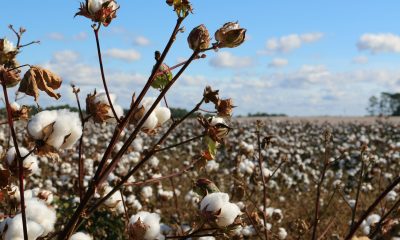Featured
FCOJ Futures Were Higher Last Week: the Market Is Short Oranges
FCOJ was higher last week and tested the recent highs on the weekly charts. Inflation and central bank actions to counter inflation have many concerns about how consumers will be affected and what the buying power of consumers might be in the end. The market is short Oranges and short juice production but is also worried about domestic demand destruction as pills are becoming cheaper again

Wheat: Wheat markets were higher last week on news that Indian production is in trouble from hot and dry weather and that the country might have to regulate exports. India has denied it will regulate exports and said it has enough in storage, but futures were higher anyway. Spring Wheat was higher on bad weather that is still in the forecast for US and Canadian growing areas. The Fed increased interest rates by 0.5% last week. Trends are sideways in all three markets on the weekly charts. Russia have been offering into the world market at relatively cheap prices but the Wheat is moving from the Black Sea although a lot of ships are scared to go on those waters. Ukraine can rail Wheat to Romania for shipment and has been doing this. Hard Red Winter Wheat was a little lower on forecasts for some light to moderate precipitation to fall in HRW growing areas of the western Great Plains this week and more moderate weather is forecast for the northern Great Plains and Canadian Prairies. The western US Great Plains remained too dry and crop conditions were very poor.
Weekly Chicago Soft Red Winter Wheat Futures
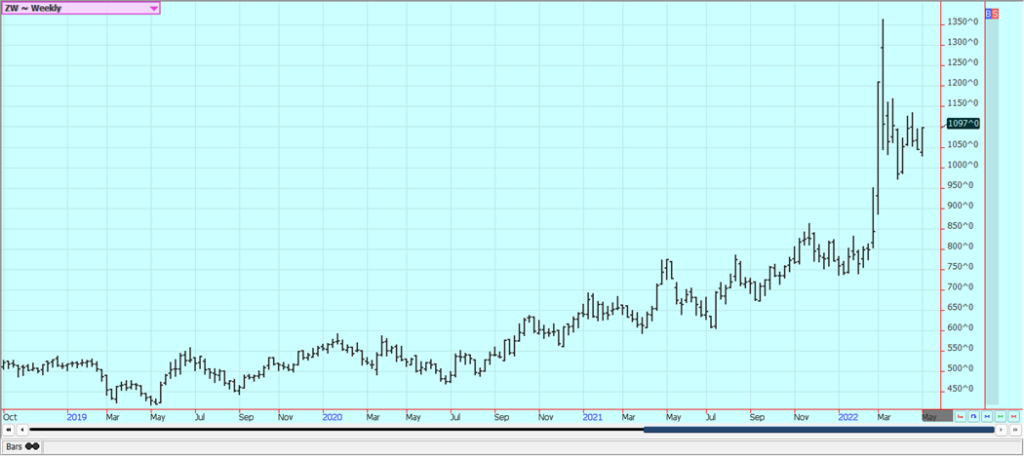
Weekly Chicago Hard Red Winter Wheat Futures

Weekly Minneapolis Hard Red Spring Wheat Futures
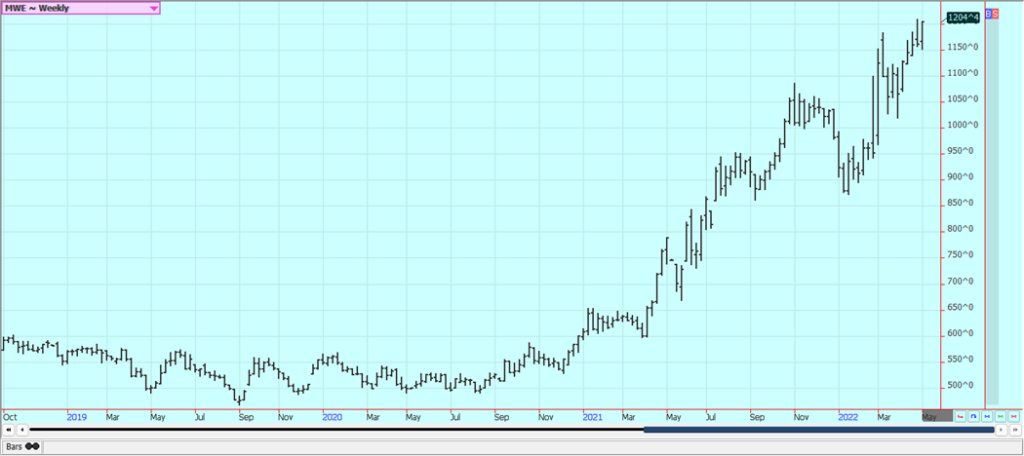
Corn: Corn and Oats closed lower last week as forecasts for better planting weather this week and Fed moves to increase interest rates and cool inflation were most important. The Fed increased interest rates by 0.5% and traders worry about the loss of demand. Very warm temperatures are forecast for the Midwest this week and ideas are that planting progress is about to increase. The crop planting progress is very slow now due to the cold and wet Spring seen here and the market started to worry about yield loss soon. It already thinks there is reduced planted area because of the March planning intentions reports from USDA. The potential loss of Ukraine exports of Corn makes the world situation tighter. China has a Covid outbreak again and has closed some cities and some ports in response. The moves are harsh but China has a no tolerance policy about the pandemic. The closings of cities and ports will hurt the economy as people can’t make or spend money and hurt imports as there will be fewer places to unload cargoes. However, China has been a very big buyer of US Corn over the last couple of weeks as they need the feed and Ukraine cannot currently offer any supply. President Biden has said he will permit the use of higher ethanol blends in gasoline this Summer in an effort to control inflation and high fuel prices.
Weekly Corn Futures
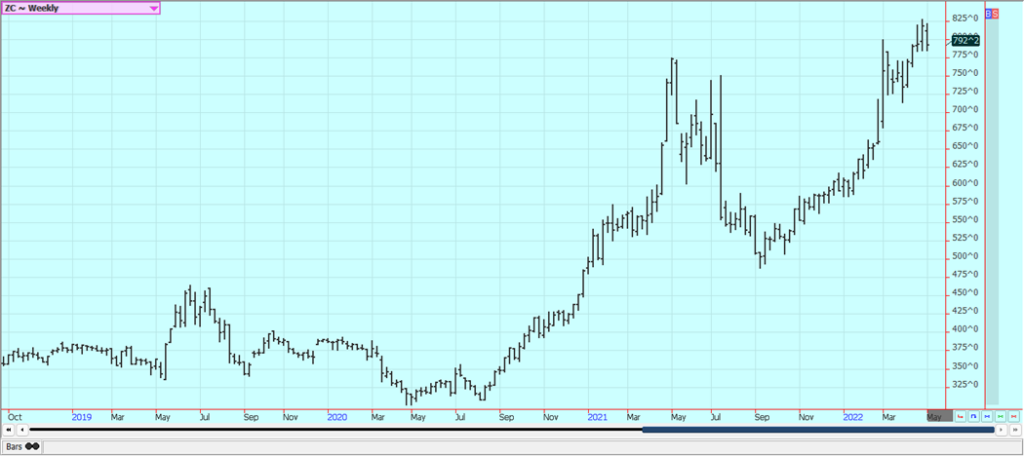
Weekly Oats Futures

Soybeans and Soybean Meal: Soybeans and the products were lower last week on fears of a cooling economy after the Fed raised interest rates and on forecasts for much improved planting weather this week. Almost summer like conditions are forecast for this week after weeks of cold and wet weather for the Midwest. The Fed raised interest rates by 0.5% this week. There were ideas that the world could be headed to a recession. Traders are worried about demand moving forward as the US Dollar is very strong and China is locking down due to Covid. Demand has been strong even with a slower export pace from the US with NOPA showing a higher crush rate. The market had been told last week that all Palm Oil exports from Indonesia were banned. President Biden has said he will support expanded use of bio fuels this Summer in an effort to control higher fuel prices. More sanctions are now threatened for Russia due to what the world is seeing in Ukraine right now. There are still worries about Chinese demand because of Covid lockdowns there. China has been a major buyer of US Soybeans this year after a very slow start due to the problems in South America and bought Soybeans again yesterday. They are buying for this year and already have booked a large amount of new crop Soybeans to cover future needs. Most of the current buying is for next year. Ideas are that the Chinese economy could slow down due to the Covid lockdowns there and cause the country to purchase less Soybeans in the world market.
Weekly Chicago Soybeans Futures:
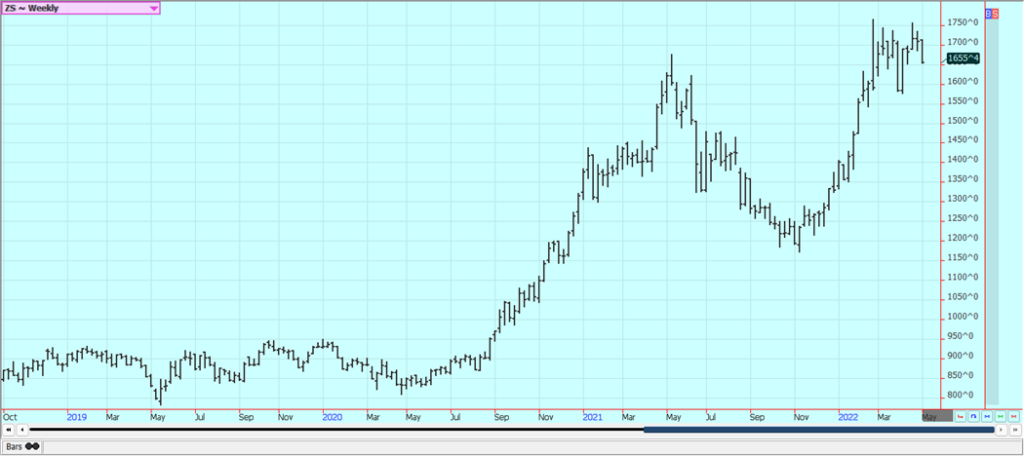
Weekly Chicago Soybean Meal Futures
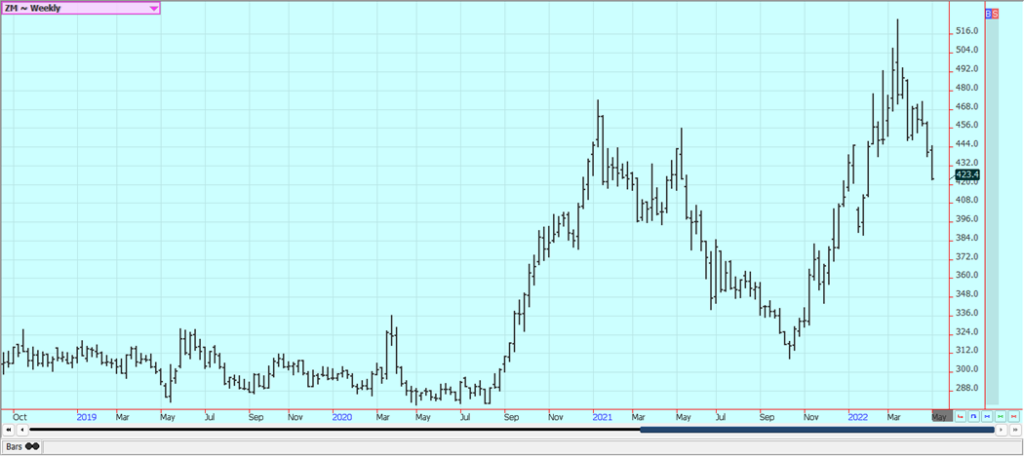
Rice: Rice was lower last week on demand concerns, but held the uptrend on the weekly charts. The Fed increased interest rates by 0.5% yesterday and ideas that demand could be hurt because of the raise were heard everywhere. There are a lot of fears of a recession coming very soon. There still was some buying seen in reaction to the slow progress in Rice planting and emergence in the US. The slow progress and wet and cold conditions in Arkansas have many looking for a lower planted area and all planted area is expected to be less, anyway, due to high input costs against the price of Rice. The overall rally is expected to continue after the current selloff and more contract highs are very possible.
Weekly Chicago Rice Futures
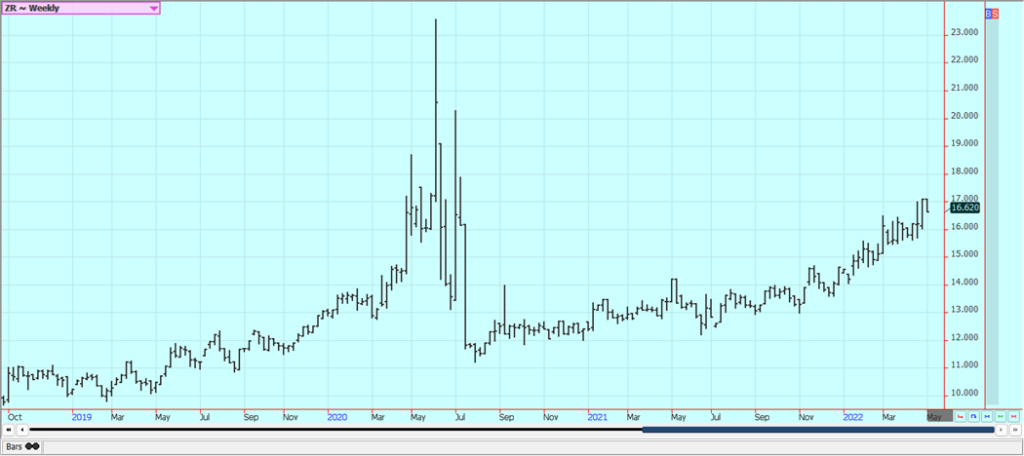
Palm Oil and Vegetable Oils: Palm Oil was lower last week and gave back the gains of the previous week. Futures were closed for the first half of the week then sold off on ideas that demand for Malaysian Palm Oil was weaker and that monthly stocks were increasing. MPOB will release its data this week. The Indonesian ban on Palm Oil products imports is now in effect and a ban on Crude Palm Oil exports is coming, according to the Indonesian government. The industry estimates the ban could last through the month of May, but the government has made no such prediction. Hopes for better demand from India keep the market supported. A new Covid outbreak is reported in China and cities and infrastructure has been shut down, including some airports and water ports. The economy could slow down and affect demand. Production from Malaysia is expected to increase as well as the Covid lockdowns finally go away and as the weather is good for production. Canola was lower last week but the losses were much less than those seen in Chicago or Malaysia. It is reported to be very dry and has been cold for planting. StatsCan said that Canadian farmers intend to reduce planted area for Canola this year and use the area to plant Wheat instead. There are ideas of reduced Sunflower export potential from Russia and Ukraine. The market is worried about South American production as well. Canada produced a very short crop of Canola last year so supplies are tight.
Weekly Malaysian Palm Oil Futures
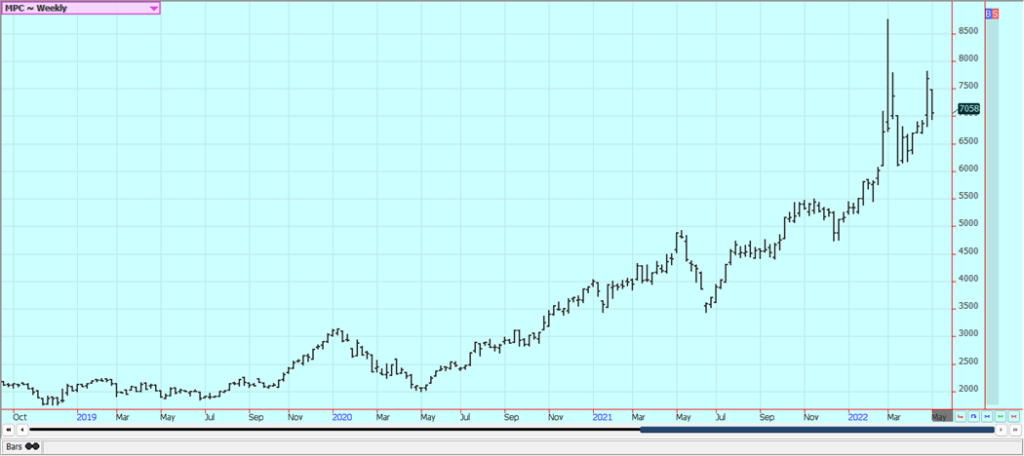
Weekly Chicago Soybean Oil Futures
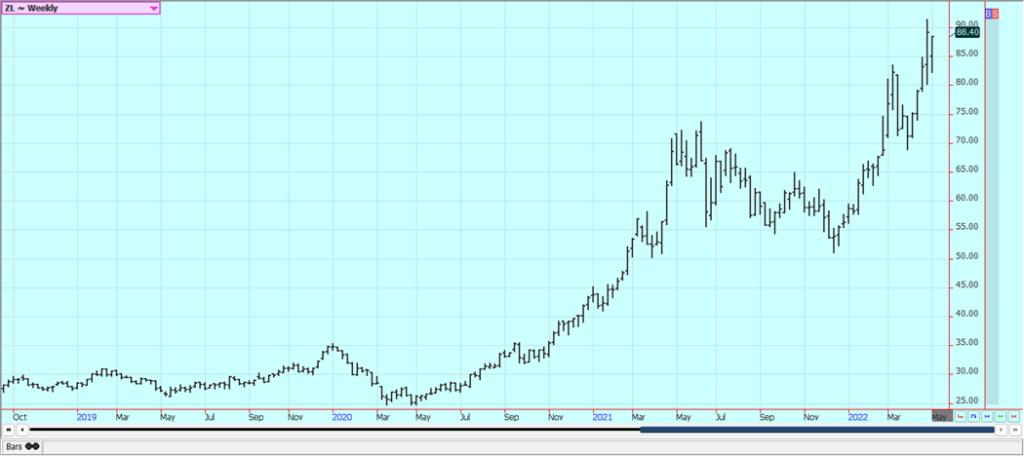
Weekly Canola Futures:
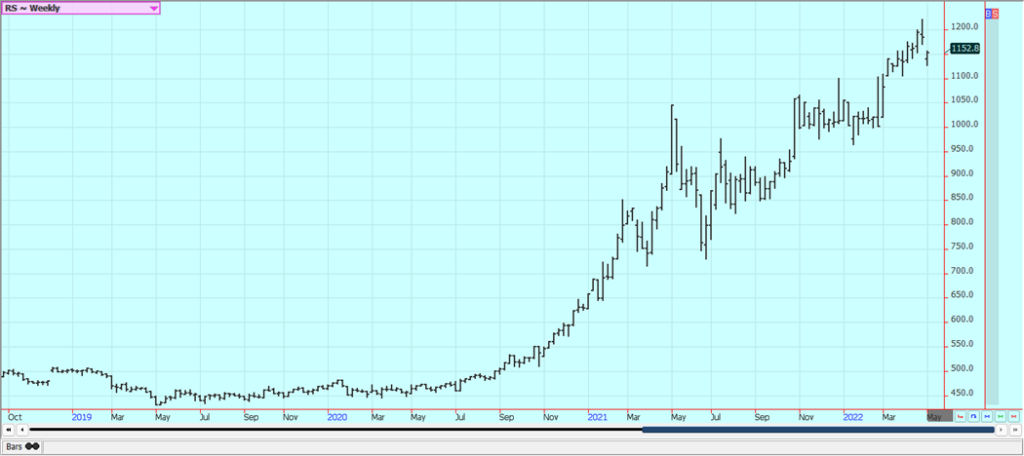
Cotton: Cotton was higher all week on a weaker US Dollar and dry conditions in the western Great Plains. Trading on Friday was lower on some long liquidation and the market surrendered the weekly gains. The Fed increased interest rates by 0.5% at its meetings last week. The trade is also worried about Chinese demand due to the Covid lockdowns there. India will now try to increase imports as world and US Cotton is now lower cost to importers as import taxes have been removed, but prices for imported Cotton are still very high. Production of the next US crop is at risk now due to dry weather in general for the western Great Plains. China could be trimming imports due to Covid and is also closing down a number of cities as the Covid spreads through the nation. China has been buying even with the port closures and domestic difficulties caused by renewed Covid lockdowns. Traders are worried about Chinese demand moving forward.
Weekly US Cotton Futures
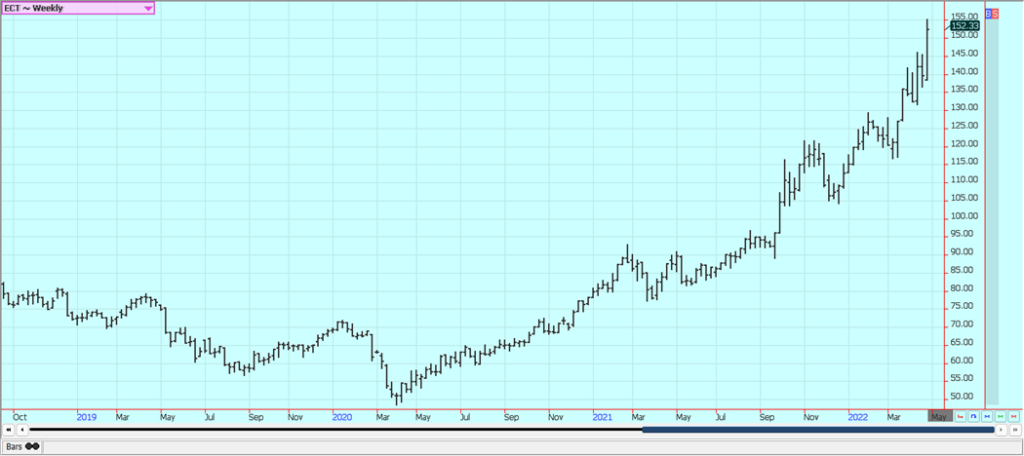
Frozen Concentrated Orange Juice and Citrus: FCOJ was higher last week and tested the recent highs on the weekly charts. Inflation and central bank actions to counter inflation have many concerns about how consumers will be affected and what the buying power of consumers might be in the end. The market is short Oranges and short juice production but is also worried about domestic demand destruction as pills are becoming cheaper again. The greening disease has taken its toll on the US crop and the previous Brazil crop was down significantly due to drought. The weather remains generally good for production around the world for the next crop. Brazil has some rain and conditions are rated good, but it is drier now and some tree stress could develop soon. Weather conditions in Florida are rated mostly good for the crops with some showers and warm temperatures. The Florida Dept of Citrus said that FCOJ stocks are now 30.2% less than last year.
Weekly FCOJ Futures
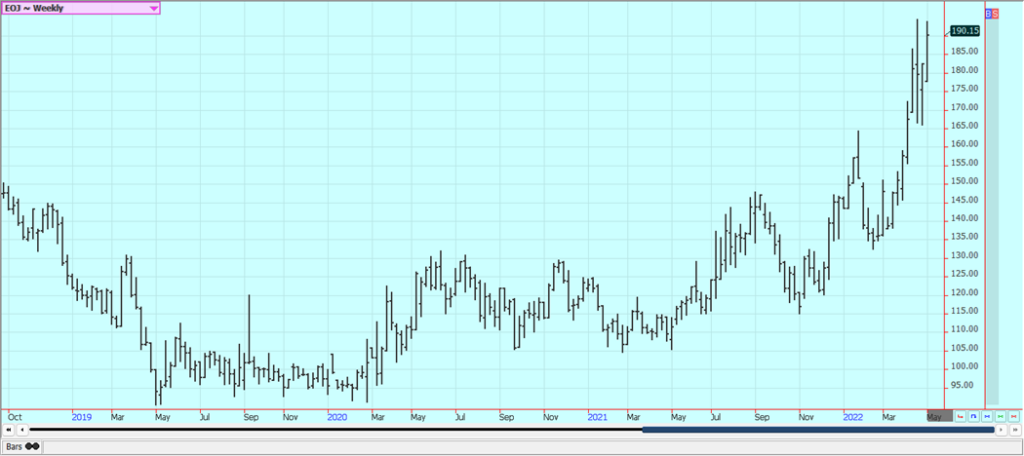
Coffee: New York and London were both higher early in the week before turning down on Friday on what appeared to be risk off selling from speculators. The Fed raised interest rates last week so there are fears of a cooling economy and less demand. The Ukraine war is also supporting ideas of less demand from Europe generally and Ukraine and Russia. A weaker US Dollar and concerns about inflation continue. Arabica offers have started to increase as the Brazilian Real has turned a little weaker, and there are still some Robusta offers hitting London. Ideas are that demand could get hurt as inflation and central bank actions hurt buying power from consumers. Demand from China is thought to be less due to the war against Covid. Deliveries from Vietnam and Brazil Robusta are noted to be decreasing as the harvest is now complete. Indonesian offers are higher due to plentiful stocks inside the country. Arabica deliveries from Brazil are less in part due to less production and in part due to a stronger Real that has cut prices paid to farmers inside the country. Less deliveries are reported from Vietnam now as producers have sold most of the crop and are holding the rest and waiting for higher prices. Good growing conditions for the next crop in Brazil are still around but flowering is reported to be uneven this year in at least some areas.
Weekly New York Arabica Coffee Futures
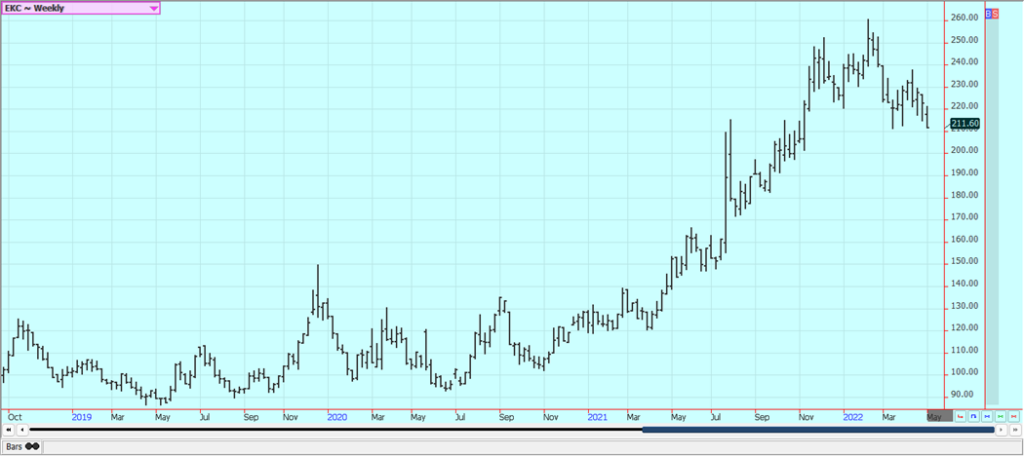
Weekly London Robusta Coffee Futures
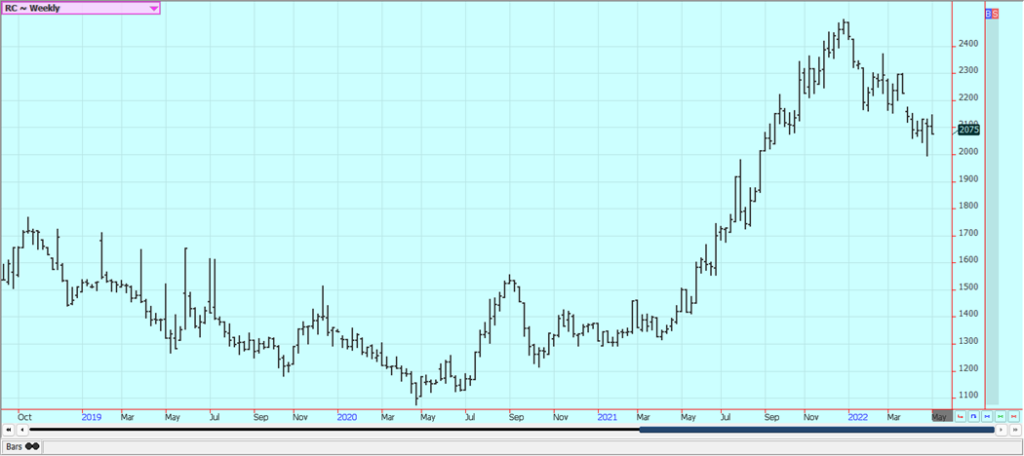
Sugar: New York and London closed a little higher last week and moved once again with world petroleum prices. The Fed raised interest rates by 0.5% in its meetings last week. The US Dollar was strong and has been strong to drive up the price in local currencies of the importers and exporters, but the sell side knows futures have fallen and are holding. Increased offers from India and Thailand are expected if the market rallies. Pakistan is also increasing its offers due to good crops there. The US government is permitting refiners to blend 15% ethanol into the fuel mixtures instead of 10% for the coming Summer, but most of the Ethanol will come from Corn. India and Thailand expect improved crops this year. Thailand expects to produce about10 million tons of sugar this year, up 33% from last year. India said it could export more than 9.0 million tons of Sugar. Brazil could also have better Sugarcane production this year but the strengthening Real implies that most of the refining will be for Ethanol and not Sugar.
Weekly New York World Raw Sugar Futures

Weekly London White Sugar Futures
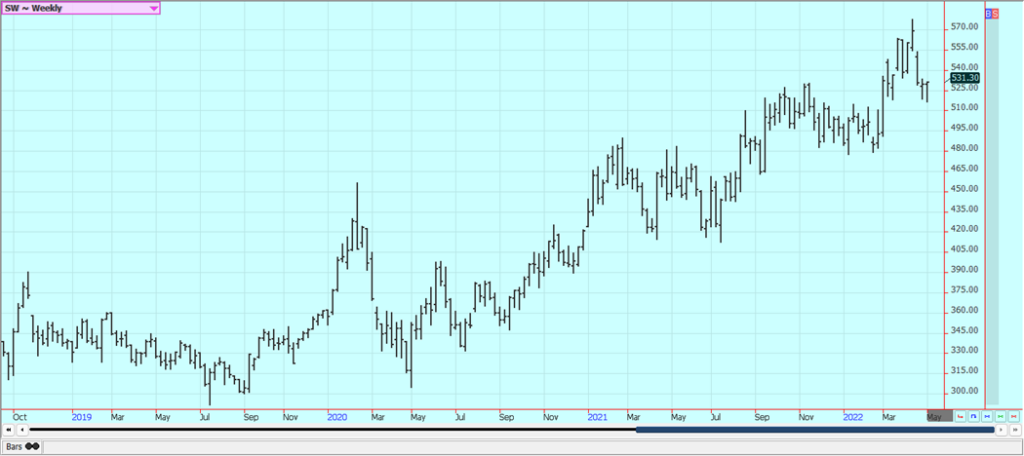
Cocoa: New York and London closed higher last week. The trends are now up on the daily charts and mixed on the weekly charts. The weather is good for harvest activities in West Africa, but some are concerned about dry weather that could affect the yields for the midcrop harvest. Some showers are in the forecast for West Africa and have been for several weeks, but the precipitation was less than normal last week and net drying is reported. The weather is good in Southeast Asia. Ghana arrivals have been below year ago levels, but Ivory Coast arrivals are ahead of last year.
Weekly New York Cocoa Futures
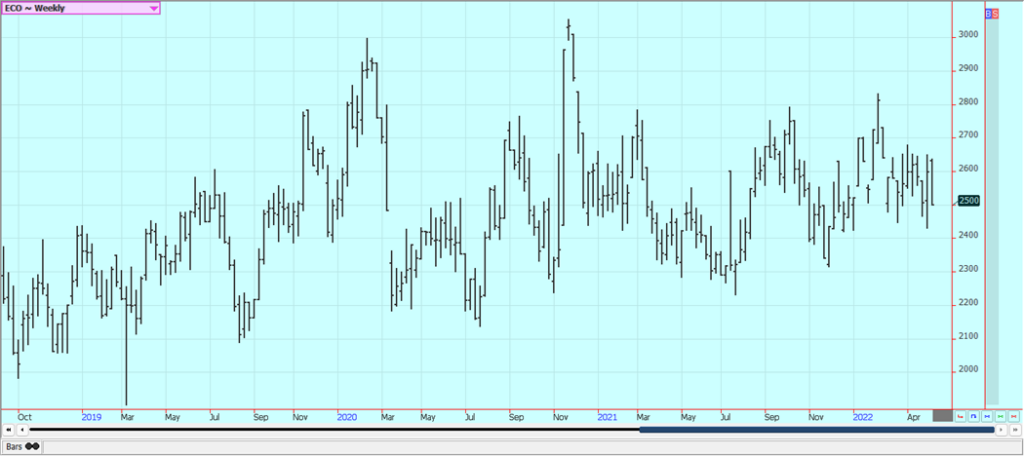
Weekly London Cocoa Futures
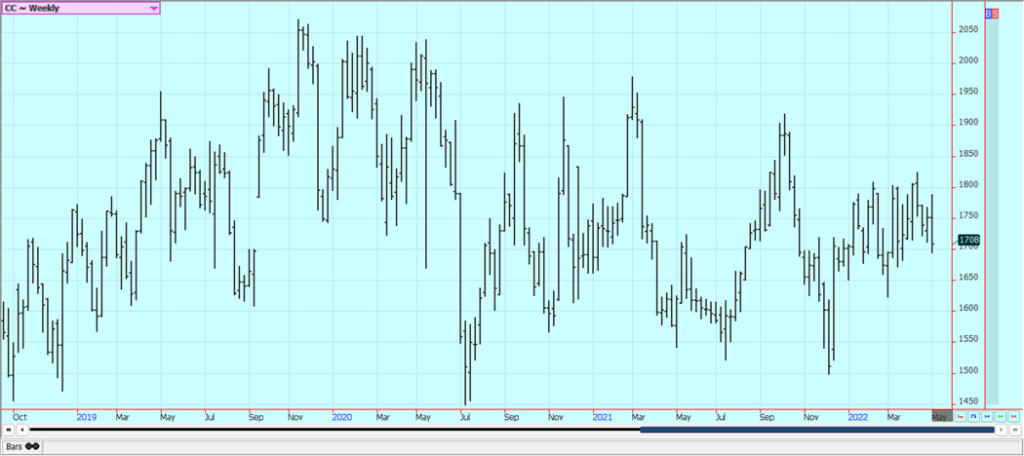
__
(Featured image by subherwal CC BY 2.0 via Flickr)
DISCLAIMER: This article was written by a third party contributor and does not reflect the opinion of Born2Invest, its management, staff or its associates. Please review our disclaimer for more information.
This article may include forward-looking statements. These forward-looking statements generally are identified by the words “believe,” “project,” “estimate,” “become,” “plan,” “will,” and similar expressions. These forward-looking statements involve known and unknown risks as well as uncertainties, including those discussed in the following cautionary statements and elsewhere in this article and on this site. Although the Company may believe that its expectations are based on reasonable assumptions, the actual results that the Company may achieve may differ materially from any forward-looking statements, which reflect the opinions of the management of the Company only as of the date hereof. Additionally, please make sure to read these important disclosures.
Futures and options trading involves substantial risk of loss and may not be suitable for everyone. The valuation of futures and options may fluctuate and as a result, clients may lose more than their original investment. In no event should the content of this website be construed as an express or implied promise, guarantee, or implication by or from The PRICE Futures Group, Inc. that you will profit or that losses can or will be limited whatsoever. Past performance is not indicative of future results. Information provided on this report is intended solely for informative purpose and is obtained from sources believed to be reliable. No guarantee of any kind is implied or possible where projections of future conditions are attempted. The leverage created by trading on margin can work against you as well as for you, and losses can exceed your entire investment. Before opening an account and trading, you should seek advice from your advisors as appropriate to ensure that you understand the risks and can withstand the losses.

-

 Fintech1 week ago
Fintech1 week agoN26 Hires UBS Executive to Lead Turnaround Amid Regulatory Pressure
-

 Biotech3 days ago
Biotech3 days agoCAR-T Therapies: From Breakthrough Cancer Treatment to Faster, Safer, and More Accessible Immunotherapy
-

 Cannabis1 week ago
Cannabis1 week agoLuxembourg’s Cannabis Paradox: Legal at Home, Restricted Everywhere Else
-

 Crowdfunding1 week ago
Crowdfunding1 week agoCommunity Energies 2026: Funding Projects Combating Youth Loneliness


